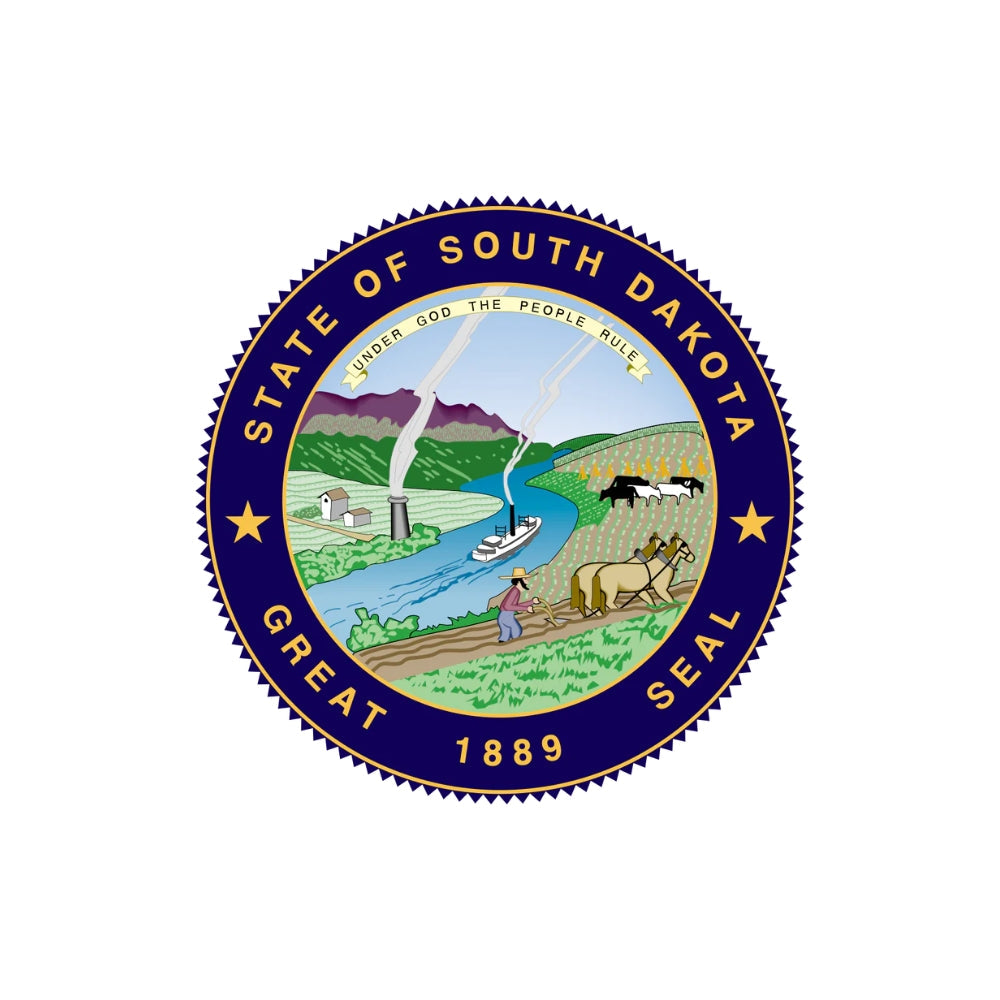Explore the Fascinating History of South Dakota
Take our South Dakota Trivia Quizzes for a Chance to Win a 6-Month Subscription to History By Mail!

The History of South Dakota
Journey Through South Dakota Trivia
Welcome to our South Dakota history and trivia page, presented by History By Mail. Join us as we embark on a journey through the captivating past and cultural tapestry of the Mount Rushmore State. From the ancient indigenous civilizations, such as the Lakota Sioux and Arikara, to the arrival of European explorers and the modern era, we'll delve into South Dakota's hidden gems and challenge your knowledge with entertaining quizzes. Let's uncover the rich history and intriguing trivia of South Dakota together.
South Dakota, known as the Mount Rushmore State, is a land of natural wonders and historical significance. From the majestic Black Hills and the Badlands to the iconic landmarks of Mount Rushmore and Crazy Horse Memorial, South Dakota holds a captivating legacy. Explore the vibrant history of the gold rush in Deadwood, the tales of Wild West legends like Calamity Jane and Wild Bill Hickok, and the profound cultural heritage of the Lakota Sioux Nation.
Join us as we unravel the intriguing history and trivia of South Dakota, delving into its role in the Lewis and Clark expedition, the preservation of Native American cultures, and the pioneering spirit of those who settled the region. Discover the stories of the Battle of Little Bighorn, the Homestake Gold Mine, the annual Sturgis Motorcycle Rally, and the rich cultural traditions of the Native American tribes. Let's explore the diverse tapestry of South Dakota's past and celebrate its unique contributions to our nation's heritage.
Facts about South Dakota
State Abbreviation: SD
Capital: Pierre
Name Origin: Dakota is a Native American Sioux word that means roughly “friendly” or “allies.”
Nickname: Mount Rushmore State; Coyote State
Statehood: November 2, 1889 (40th State)
State Motto: "Under God the people rule"

South Dakota's Flag
The State Flag of South Dakota features a striking and distinctive design that embodies the spirit and history of the state. The flag consists of a royal blue field with the state seal prominently displayed in the center.
At the center of the seal is a picturesque scene that showcases South Dakota's natural beauty. The scene depicts a landscape with rolling hills, a river, and a range of mountains in the background. A shining sun rises above the mountains, symbolizing the state's bright future.
In the foreground of the seal, there are two important symbols. On the left side, a farmer is shown plowing a field, representing the state's strong agricultural heritage and its hardworking people. On the right side, a steamboat sails on the river, representing the importance of waterways in South Dakota's history and commerce.
Encircling the scene are the words "South Dakota" written in gold letters, emphasizing the state's identity. Above the seal, there are several golden rays extending outward, symbolizing the state's positive outlook and optimism.
South Dakota's Great Seal
Enacted within the 1889 South Dakota constitution, the state seal gained legal status. In 1961, the colors for the seal were officially designated by law. This emblem encompasses multiple depictions, capturing the state's landscape and historical economic activities. A farmer plows fields in the foreground, while a river with a steamboat meanders through the middle. On the left, a smelting furnace stands, while the right features a cattle herd and a cornfield. In the background, a range of hills is depicted to the left. Towards the upper edge, the state motto "Under God the People Rule" is inscribed.

--- State Trivia #1 ---
History of South Dakota
The exploration of the area now known as South Dakota began in 1743 when French explorers Louis-Joseph and François Verendrye ventured in search of a route to the Pacific Ocean. Subsequently, the United States acquired the region through the Louisiana Purchase in 1803, with the famous expedition of Lewis and Clark further exploring the area from 1804 to 1806. In 1817, the first permanent settlement, Fort Pierre, was established.
However, significant settlement in South Dakota did not occur until the arrival of the railroad in 1873 and the discovery of gold in the Black Hills in 1874, sparking a rush of people seeking fortune and a new beginning.
While agriculture has long been a cultural and economic cornerstone of the state, South Dakota has seen a shift in its economic landscape. Durable-goods manufacturing and private services have emerged as key drivers of the economy, alongside a flourishing tourism industry that generates over a billion dollars in economic activity annually.
South Dakota holds prominence as the second-largest producer of sunflower seed and oil in the nation. It is also a leading producer of various small grains, including oats, barley, rye, flaxseed, sorghum, and alfalfa.
The Black Hills, the highest mountains east of the Rockies, captivate visitors with their majestic beauty. Among the notable attractions within this range is Mount Rushmore, where the granite likenesses of Washington, Jefferson, Lincoln, and Theodore Roosevelt were meticulously carved by Gutzon Borglum. Additionally, an ongoing granite carving project near Custer memorializes Crazy Horse, an iconic figure in Native American history.
South Dakota boasts other captivating tourist destinations as well. The Badlands showcase stunning geological formations, while Mitchell proudly boasts the World's Only Corn Palace, a unique architectural gem. The city of Deadwood, historically significant for the death of Wild Bill Hickok in 1876, recently legalized gambling, adding to its allure.
In recent years, the agricultural landscape in South Dakota has undergone changes. According to a report from the U.S. Department of Agriculture (USDA), the number of farms in the state has decreased, while the average farm size has increased. While the number of farms decreased to less than 300 in 2012, the average size expanded by 13 acres, reflecting shifting dynamics in the agricultural sector.
South Dakota's history, natural beauty, and evolving economy make it a state with a fascinating past and promising future. Whether exploring its rugged landscapes, delving into its cultural heritage, or witnessing its agricultural and industrial contributions, South Dakota offers a diverse array of experiences for visitors and residents alike.
State Symbols
Fun Facts
- Nearly three million people visit Mount Rushmore each year.
- Famous folks who lived in South Dakota include newscaster Tom Brokaw, Sioux Indian chief Crazy Horse, author Laura Ingalls Wilder, Calamity Jane, and Dakota Indian chief Sitting Bull.
- Started in 1948, the Crazy Horse Memorial is still being carved today in the Black Hills. When finished, the statue will be 563 feet high, almost twice as tall as the Statue of Liberty!
- Drive a covered wagon, make a corncob doll, and spend a day living the pioneer life at Laura Ingalls Wilder’s historic homestead in De Smet, South Dakota.
--- State Trivia #2 ---

Things To Do in South Dakota
- Visit Mount Rushmore: Marvel at the iconic Mount Rushmore National Memorial, where the faces of Presidents George Washington, Thomas Jefferson, Abraham Lincoln, and Theodore Roosevelt are meticulously carved into the granite mountainside. Explore the visitor center, take scenic hikes, and learn about the history and significance of this national landmark.
- Explore Badlands National Park: Immerse yourself in the unique and rugged beauty of Badlands National Park. Witness striking rock formations, deep canyons, and expansive prairies. Take a scenic drive along the Badlands Loop Road, hike the trails, spot wildlife, and capture breathtaking views of the otherworldly landscapes.
- Experience Custer State Park: Discover the natural wonders of Custer State Park, known for its diverse wildlife, scenic drives, and outdoor recreational opportunities. Drive along the famous Wildlife Loop Road to encounter herds of bison, deer, and other animals. Hike to Cathedral Spires for stunning views or enjoy fishing, boating, and swimming in the park's lakes.
- Step into history at Deadwood: Immerse yourself in the Wild West history of Deadwood, a historic town that once attracted legends like Wild Bill Hickok and Calamity Jane. Stroll along the streets lined with historic buildings, visit museums, try your luck at the casinos, and catch a reenactment of the town's colorful past.
- Discover the Black Hills: Explore the beauty of the Black Hills region, which encompasses not only Mount Rushmore but also other scenic attractions. Visit the Crazy Horse Memorial, an ongoing carving project honoring the Native American leader. Take a scenic drive through Spearfish Canyon, hike to Harney Peak, the highest point in South Dakota, or enjoy outdoor activities like fishing, camping, and rock climbing in this picturesque area.

General Map of South Dakota
South Dakota, known as the "Mount Rushmore State," is a captivating destination located in the north-central region of the United States. Renowned for its stunning landscapes, Native American heritage, and outdoor adventures, South Dakota offers a wealth of experiences for visitors to explore and enjoy.
Famous People From South Dakota
--- State Trivia #3 ---
FREQUENTLY ASKED QUESTIONS (FAQ) ABOUT SOUTH DAKOTA
South Dakota's name is derived from the Sioux Dakota tribe, which inhabited the region before European settlers arrived. "Dakota" is a Sioux word meaning "friend" or "ally."
South Dakota was admitted to the United States on November 2, 1889, becoming the 40th state in the Union.
Mount Rushmore, located in the Black Hills, features the carved faces of four U.S. presidents: George Washington, Thomas Jefferson, Abraham Lincoln, and Theodore Roosevelt. This iconic monument symbolizes the nation's history and cultural heritage.
South Dakota is often referred to as the "Pheasant Capital of the World." The state boasts a large population of pheasants, making it a popular destination for hunting enthusiasts from around the country.
Related Resources
- Official Website of the State of South Dakota: The official website provides information about the state government, services, business resources, and more. Visit: https://sd.gov/
- South Dakota Department of Tourism: Explore South Dakota's attractions, scenic landscapes, outdoor activities, events, and plan your trip. Visit: https://www.travelsouthdakota.com/
- South Dakota State Historical Society: Learn about South Dakota's history, cultural heritage, historic sites, museums, and educational resources. Visit: https://history.sd.gov/
- South Dakota Game, Fish, and Parks: Discover South Dakota's diverse natural resources, state parks, camping, fishing, hunting, and outdoor recreation opportunities. Visit: https://gfp.sd.gov/
- Mount Rushmore National Memorial: Explore the iconic monument featuring the faces of George Washington, Thomas Jefferson, Abraham Lincoln, and Theodore Roosevelt. Learn about its history, visitor information, and educational resources. Visit: https://www.nps.gov/moru/index.htm
- Crazy Horse Memorial: Learn about the ongoing construction of the monumental sculpture dedicated to Crazy Horse, explore Native American culture, and plan your visit. Visit: https://crazyhorsememorial.org/
- South Dakota State Fair: Discover the annual state fair showcasing agriculture, entertainment, food, livestock exhibitions, and family-friendly activities. Visit: https://www.sdstatefair.com/
- Badlands National Park: Explore the unique geological formations, fossil exhibits, hiking trails, and wildlife in this captivating national park. Visit: https://www.nps.gov/badl/index.htm
- Custer State Park: Experience the beauty of the Black Hills, wildlife viewing, scenic drives, hiking, camping, and outdoor adventures in this picturesque state park. Visit: https://gfp.sd.gov/parks/detail/custer-state-park/
- The Journey Museum and Learning Center: Learn about the history, culture, and natural resources of the Black Hills and the Great Plains region. Visit: https://www.journeymuseum.org/





